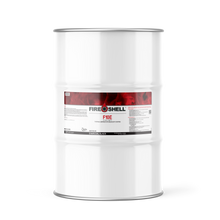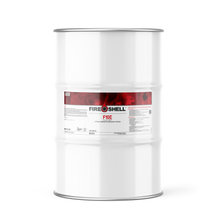
About this Product
Product Specifications:
Approvals:
- Meets NFPA 285 multi story Fire resistance over sprayfoam for ACM aluminum/sprayfoam commercial wall assemblies.
- Meets IBC 803.2.1 over foam
- Meets IBC 2603.9 over foam
- Meets IRC 314.3 over foam
- The first coating to pass NFPA 286 over Foam
- Water based, 1-part, non-flammable, intumescing coating for interior use
- E84 Cl ‘A’ verified
- Meets Green Standards and Lead Paint Requirements
- Meets EPA certification for Ultra Low VOC coating
APPLICATION PROCEDURES
The successful installation and effectiveness of
FireShell® F10E will depend on many factors including the equipment capabilities & settings, the temperature of the coating in the container, ambient temperature & RH%, substrate temperature & moisture content, substrate type & condition. It is the responsibility of the applicator to take these factors into consideration prior to installation. Cold material will develop higher viscosity which can cause problems during processing such as pump cavitation and poor pre-mixing material. If material appears thickened due to storage at cold temperatures, store material in a warm area prior to application to bring material temperature to > 62° F. FireShell® F10E can be applied with airless spray equipment. Areas requiring special detail or touch up can be brushed or rolled. When using airless spray equipment ensure the equipment has a volume output not less than 0.74 gpm (gallons per minute) and an operating pressure of 3300 psi. The sprayer should be equipped with a filter screen 30-mesh. To ensure proper pressure and delivery to the spray gun use the following rules for hose diameter & length:
- Min. 3/8” ID up to 75’
- Min 1/2” ID up to 200’
- Min 3/4” ID greater than 200’
- Min 3/8” ID & Max 6’ L for whip hose
Always use larger diameter hose sections nearest the pump.
SURFACE PREPARATION
SURFACE TEXTURE OF SPF WILL GREATLY AFFECT MATERIAL ADHESION, SAG RESISTANCE, AND COVERAGE RATE.
SPF surface should have a fine, orange-peel texture (or rougher), and be flat for optimum adhesion and material coverage. SPF surface that is bumpy, or significantly uneven will decrease coating coverage. SPF that has a glossy or slick appearance may need to be abraded or “scuffed” to roughen the surface to promote adhesion of coating. SPF surface must be clean, dry and free of any mildew, oil, grease, dirt, or other foreign contaminants that would prevent proper adhesion. Any such contaminants must be removed from the application surface. For application in high humidity or low temperature environments apply product in thin passes to promote proper drying & curing.
Please see TSD for more information
- Choosing a selection results in a full page refresh.
- Press the space key then arrow keys to make a selection.







